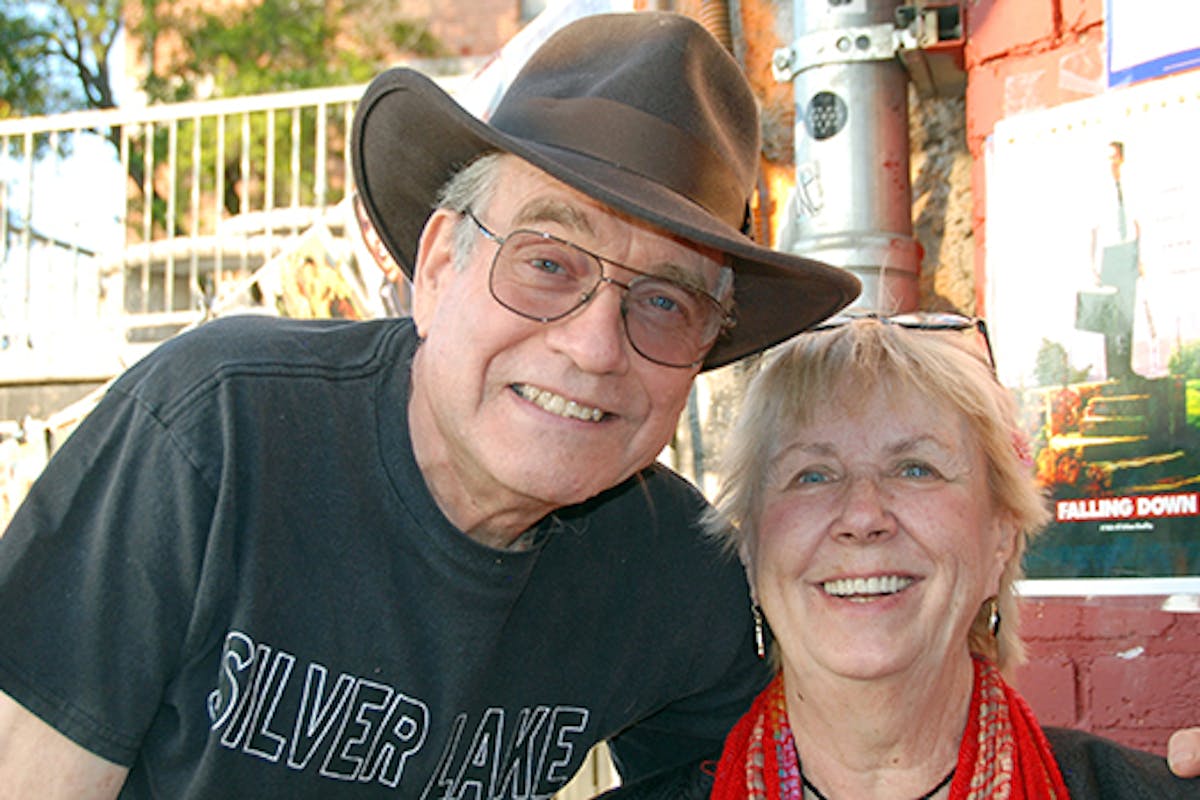Finding His Voice: In Celebration of Jewish Heritage Month, A Retired TFT Lecturer Shares His Hollywood Story

By Vincent Brook
I was born in 1946 and raised in the San Fernando Valley on a chicken farm. One of my earliest memories is riding my tricycle to the chicken coops in the morning and collecting eggs, which our family ate for breakfast. My German Jewish émigré parents, Rudy and Eva Brook, had purchased the farm, complete with an apricot orchard whose fruit we peddled on the street, after barely escaping the Nazi terror — though several of our closest relatives did not.
My father had passed the German bar in 1933 but couldn’t practice law because of the newly instituted anti-Jewish laws. He then worked for Hechalutz, the leading Zionist organization. His job was to match-make couples who were total strangers, because married couples had a better chance of getting visas to Palestine, and through this ruse he ultimately saved thousands of Jews from perishing in the Holocaust. My mother found employment for a few years teaching at a school for Jewish children who’d been barred from public schools.
Seeing the writing on the wall, my parents fled to the United States in 1938, and their foresight was uncannily borne out. They docked in New York, with only $10 to their name, on Kristallnacht (Night of the Broken Glass) — the pogrom throughout Germany and Austria that foreshadowed the Holocaust.
In America, things worked out amazingly well. My mother got a job as a massage therapist at a fellow German Jewish émigré friend’s salon in Hollywood. The salon catered to the elite among the burgeoning, German-speaking exile community, who were primarily Jewish, and to Hollywood celebrities, including Charlie Chaplin. She then passed along some of her A-list clients to my father, who was starting out as a gardener. Before long, his clientele boasted a Who’s Who of European refugees as well as big-name movie people, often one and the same. These included George Gershwin’s lyricist brother, Ira; famed directors Fritz Lang, Douglas Sirk and Vincente Minnelli; renowned cinematographer Karl Freund; author Vicki Baum, who wrote the novel, play and screenplay for 1932’s Oscar-winning Grand Hotel; and marquee actors Peter Lorre, Robert Ryan, Cornel Wilde and Judy Garland.
When I was 10 or 11, my father took me on his gardening rounds. I met Peter Lorre and Robert Ryan, who were both much nicer in person than they appeared in their film noirs, and Cornel Wilde, who was just as dashingly handsome and charming as in his trademark swashbucklers. Though I never met Judy Garland, I was told I’d been born in the same East Hollywood hospital and around the same time as her daughter, Liza Minnelli. Our entire family became friends with Karl Freund and his family, who invited us to their home for a dip in their swimming pool, something special at the time. I’ll never forget spending most of my swim time searching for Mrs. Freund’s voice, which someone said she’d lost at the pool. On another occasion, Mr. Freund got us front-row seats for a filming of I Love Lucy, for which he was the chief cinematographer. This was another big thrill for me, and a feather in my cap with my schoolmates.
My connection to the entertainment industry and German Jewish émigrés continued in 1963, when I was 17. That year, my parents sold the chicken farm and with the windfall built a mid-century modern house overlooking the ocean in tony Pacific Palisades. The Palisades had more to offer than spectacular beauty to émigré German Jews. The cream of the European exiles who’d settled in Los Angeles in the 1930s and 1940s, many to work in Hollywood, had gravitated to L.A.’s Westside beach communities, resulting in nicknames for the area such as “Ghetto under Pacific Palms” and “Weimar by the Sea.”
Our street, Paseo Miramar, was especially rich in refugee lore and media and literary history, past and ongoing. Just above us lived TV and film director Lamont “Monty” Johnson (Fear on Trial, Lipstick) as well as TV writer and producer Jerry Mayer (Tabitha, The Facts of Life). Just below lay the former abode of classical Hollywood director Frank Borzage (A Farewell to Arms, The Mortal Storm) and the crème de la crème, the Villa Aurora of the late great German Jewish novelist Lion Feuchtwanger (Jud Süß, The Josephus Trilogy) and his still-living salonniere wife, Marta. The weekend gatherings at their palatial estate during and after World War II had featured a host of eminent émigré artists and intellectuals, including some of my parents’ massage and gardening clients.
Influenced by my brush — literally and through my parents — with Hollywood glitterati, I acquired a special love for the movies, eventually took film classes at Los Angeles Community College and became a professional film editor. In the 1970s, I worked on a series of TV and feature documentaries for International Television Film Productions in Hollywood. In the early 1980s, through my parents’ contact with Richard Meyer, another German Jewish émigré and the Oscar-winning editor of 1969’s Butch Cassidy and the Sundance Kid, I served as his assistant on The Unseen, a low-budget indie that unfortunately lived up to its title.
My life as an academic began when back problems prevented me from continuing as an editor, which was still a quite physical job in the ’80s. With my professional experience and a bachelor’s equivalent in film, I started teaching film history at Pierce College in Woodland Hills and, after going back to school to earn advanced degrees at UCLA, I taught media studies at Cal State LA, USC Annenberg School for Communication and Journalism, and at UCLA TFT.
Before that, though, in one of my graduate courses at UCLA, I had stumbled upon a popular 1950s sitcom, The Goldbergs. Its subject, about an immigrant Jewish family in New York City, with children born in America, obviously struck a chord with me, and my essay for the course won a national student writing award and was published in Cinema Journal. This encouraged my further pursuit of Jewish issues in film and television, a comparatively young field at the time.
I went on to write dozens of journal and anthology essays, and published my first book, Something Ain’t Kosher Here: The Rise of the “Jewish” Sitcom, in 2003. This examined the unprecedented explosion in the late 1980s and 1990s of American sitcoms with explicitly identified Jewish protagonists — over 40 by my count, compared to a mere seven in the previous 40 years. This televisual “coming out,” if you will, also corresponded to and resonated with the rise in my own Jewish self-consciousness then and during the years that followed.
My third book, Driven to Darkness: Jewish Émigré Directors and the Rise of Film Noir (2009), more directly channeled my parents’ Nazi-era experiences and incorporated the work of some of their clients, such as Fritz Lang, Peter Lorre, Robert Ryan and Karl Freund. My visit in the mid-2000s to my grandfather Hans Eger’s grave at the Theresienstadt concentration camp further deepened my emotional relationship to my own and my parents’ Jewishness.
This new dimension to my Jewish identity was brought home in my documentary lecture class at UCLA TFT, when shortly after my concentration camp visit, I screened Alain Resnais and Jean Cayrol’s classic Holocaust documentary Night and Fog (1956). I had previously shown the film numerous times, at UCLA and at my other schools. I was always tremendously moved by it and insisted on following every screening with a discussion of the powerful and still relevant issues it raised. But on this particular occasion, as I started the discussion, I began sobbing and then completely broke down, waving to one of my TAs to take over for me.
As painful as this experience was (and other contacts with Holocaust material have produced similar reactions), I’m grateful that I was finally able to tap my repressed feelings about the Holocaust, and its repercussions for me and my family. I continued to show Night and Fog in subsequent classes and managed to lead my own discussions without breaking down — so long as I refrained from watching the film.
My latest book, All About Eva: A Holocaust-Related Memoir, with a Hollywood Twist (2021) was another offshoot of the Night and Fog experience. Based on my since-deceased parents’ writings and an interview I’d taped with my father, along with imagined recreations of some of their experiences, the book deals in-depth and on a personal level with their struggles in Nazi Germany, the tragic loss of their loved ones and their Hollywood-aided, rags-to-riches climb in Los Angeles.
My own climb relates to a greater understanding and appreciation of my Jewish identity. Both my parents’ émigré background and my involvement with Jewish issues in my academic teaching and writing career played a major part in this increased awareness. And through this unique combination of collective and personal experience, while I never managed to find Mrs. Freund’s voice, I finally found my own.

